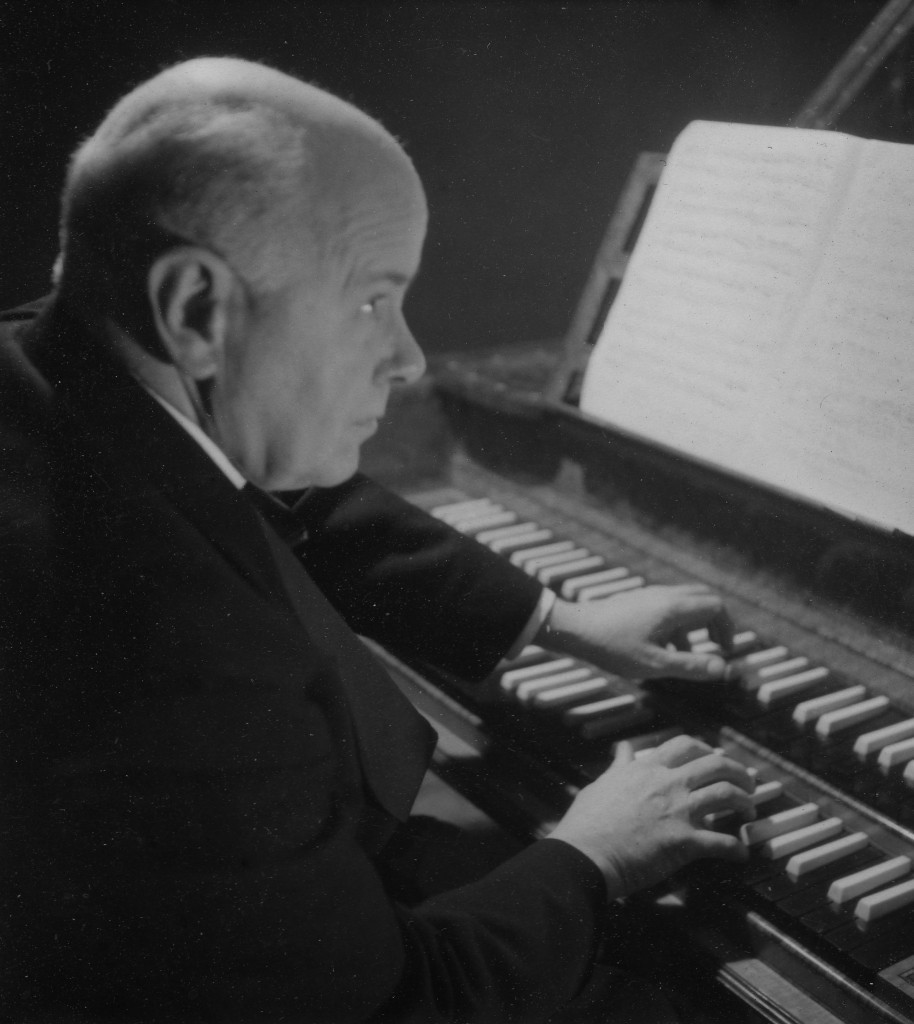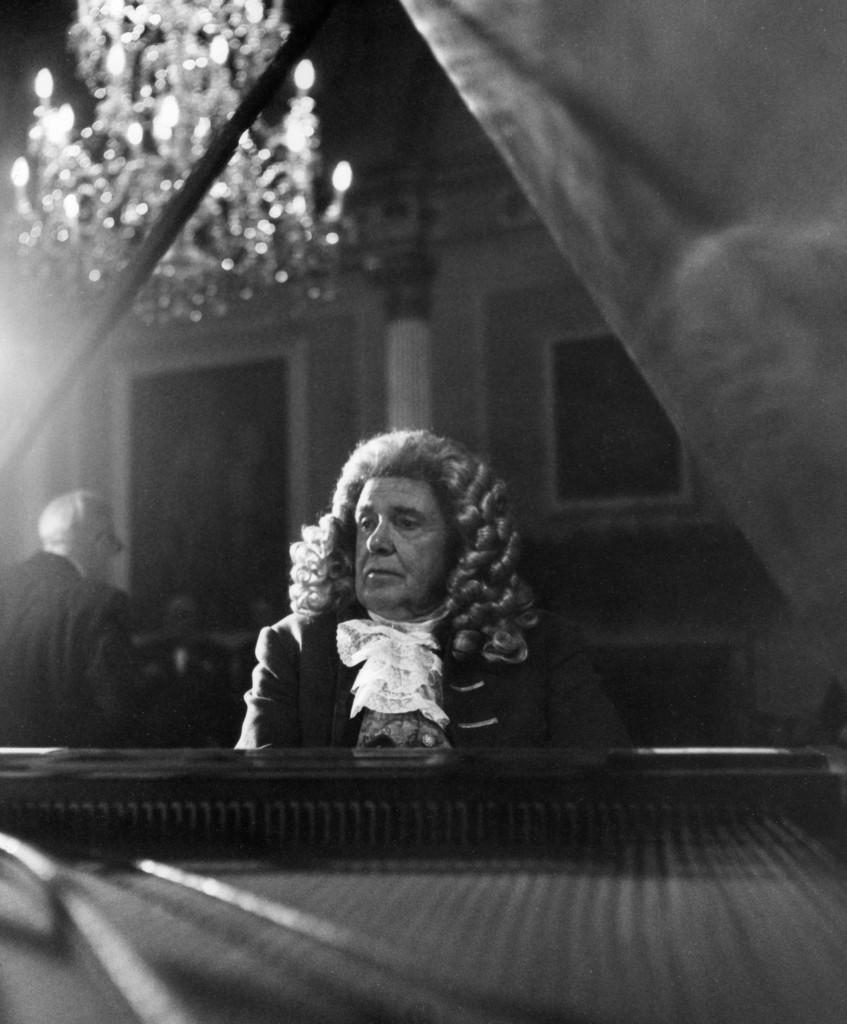This short biography of Charles Thornton Lofthouse was sent us by his daughter, Hermione Lockyer, and it is published here with some editorial additions and clarifications. We are very grateful to Ms Lockyer for her generosity in providing this valuable information.
My father, Charles Thornton Lofthouse (1895–1974) had a long and busy career as professor at the Royal College of Music, London (1922–71), director of music at Westminster School and Reading University, founder and conductor of the University of London Music Society, music examiner, and researcher, but he would have most liked to be remembered as a harpsichordist.
He played an important and distinguished part in the re-establishment of the harpsichord as the only instrument for the performance of music originally written for it, and in the development of the art of continuo playing.
The harpsichord had not been his first instrument, however. Early in his career, after the First World War, he had studied the organ with Walter Parratt and conducting with Adrian Boult at the Royal College of Music, and the piano with Alfred Cortot in Paris. As accompanist and continuo player with the London Bach Choir for many years from 1921 onward, he played continuo at the choir’s performances of Bach’s Passions on the piano under Ralph Vaughan Williams’ baton (1921–28) before turning to the harpsichord in performances with Reginald Jacques (conductor 1932–60) and becoming the first person to play a harpsichord in the Royal Albert Hall on 3 April 1938.
A lifetime at the keyboard
My father made a lifetime study of a wide range of keyboard instruments. In the years before he could afford a harpsichord of his own, he was lent a Pleyel belonging to Sir Adrian Boult (conductor of the Bach Choir 1928–31). After the Second World War, he used the cheque presented to him on his resignation as Head of Music at Reading University to acquire a clavichord made by his friend Thomas Goff, a harpsichord and clavichord maker who had also designed a lute for Julian Bream. Tom made him a lovely instrument (now in the possession of Christopher Hogwood) with beautiful hinges and ‘C.T.L.’ inscribed in brass at the end of the keyboard [see a photo here].
Please subscribe to this blog – in the top right corner – and receive notifications of new posts by email.
Later my father bought another Goff clavichord with an extra octave in order to play Scarlatti. When Hubert and I, his children, left our Chelsea home my father was able to buy his longed-for harpsichord – a beautiful instrument, also made by Tom.
To Londoners who attended the Bach performances in the Albert Hall and Royal Festival Hall in their thousands, my father was a familiar figure, seated at the modern harpsichord in the centre of the orchestra and playing from a copy of the original full score by Bach of the St Matthew which he had obtained via a friend in Germany.
From its mere figured bass he wove “with a thousand delicate nuances” (as one distinguished critic put it) the extempore harmonies which link orchestra and voices into one organic whole. Another critic commented, “There is a wizardry in the Doctor’s touch”; while Gordon Jacob wrote, “His realisations of thorough-bass were distinctive, yet always idiomatically sound, and added much to the stylishness of the Bach Choir’s performances.”
Over his long career he performed in many places around Britain (Bristol, Bath, Oxford, Reading, Winchester, Liverpool, as well as London and the East Sussex & West Kent Choral Festival) with many well-known musicians, including the pioneering viola da gamba player Ambrose Gauntlett. He played the continuo with Cuthbert Bates conducting in Bath Abbey from the inception in 1946 of the Bath Bach Festival until 1973. At the 1954 Festival he also performed in a concert with four harpsichords, with George Malcolm, Eileen Joyce, and Boris Ord, with Raymond Leppard as harpsichord continuo.
Perhaps the most famous singer he accompanied was Kathleen Ferrier, who made her London debut in 1943, with the Bach Choir at Westminster Abbey. Peter Pears was also a soloist in this performance. She appeared several more times thereafter in the St Matthew up to 1952. Early in the 1950s Decca made a recording of the Bach Choir conducted by Reginald Jacques in a complete performance of the St Matthew. The recording took place in the Kingsway Hall, with Kathleen Ferrier as one of the soloists and my father playing the harpsichord continuo.
He himself conducted the St Matthew Passion, with Ann Dowdall, Helen Watts, Kenneth Woolam, Gordon Clinton and John Shirley-Quirk, in 1962, and on 31 January 1965, he directed the East Sussex & West Kent Festival Choir and Orchestra, at a concert in honour of the 60th birthday of Michael Tippett, in which the Deller Consort, Walter Bergmann (harpsichord) and William McKie (piano) took part.
Gustav Leonhardt
My father was also an inspiring harpsichord teacher who influenced many students at the Royal College of Music during his fifty years there. He taught the harpsichord from 1934 onward; and later in his life, in 1960 [aged 65] he himself returned to study of the harpsichord, taking sabbatical leave to research harpsichord playing with Gustav Leonhardt in Amsterdam and Aimée van der Wiele, a Belgian harpsichordist and former student of Wanda Landowska, in Paris.
Further afield
In 1956, while on an examination tour in New Zealand for the Associated Board of the Royal Schools of Music, my father and Sir Keith Falkner took part in a performance of the St Matthew in Wellington, with my father playing the continuo and Keith singing the part of Christ. [Hear Falkner singing Purcell here, recorded in 1935, with John Ticehurst, harpsichord, and Bernard Richards, cello.]
The New Zealand broadcasting company had ordered a Goff harpsichord from London. Amazingly it arrived at the same time as my father’s visit, and he was the first artist to play it, at a 2YA [radio station] concert broadcast with the National Orchestra from Wellington.
From 1961 to 1965 he toured continental Europe with the Anglian Chamber Soloists. He appeared as a continuo, chamber or solo harpsichordist throughout Europe and in the USA, for instance at the Schloss Mirabell in Salzburg, the Nymphenburg Palace in Munich – on an ornate harpsichord decorated in white and gold to match the baroque ornamentation of the building – and the Eggenberg Palace in Graz.
Bach
My father’s contribution to the study and interpretation of the works of Johann Sebastian Bach stands out with particular prominence in his many-sided career. Not only did he take a leading part in the remarkable revival of Bach’s music during his lifetime, but his special and important achievement was that he revived the harpsichord continuo to its original and intended function in the interpretation of the works of the great master. He gave lecture recitals “In Praise of Bach” and other great composers around the world. He also published Commentaries and Notes on Bach’s Two- and Three-Part Inventions (London, 1956). The cover of this publication was designed by Irene Lofthouse, his artist wife.
In the words of The Times, he was “one of our senior Bachians”, and a doyen of English continuo players.
© Hermione Lockyer 2013



Charles Thornton Lofthouse was also the second conductor of Twickenham Musical Society (now Twickenham Choral Society) for around three years from the 1922/23 season (it was founded in 1921).
Dr. Lofthouse was a very good musician and teacher.
He helped me to become a harpsichordist and continuo player.
He had a certain similarity with BACH as a man and also as a keen player and interpreter of BACH’s continuo parts. I remember him with great respect and honor.
prof. dr. Hans van Dijk
emeritus in musicology
Hombourg / Belgium
I very much enjoyed reading this. CTL was a senior continuo player when I was a young student starting out as a continuo player. I have a Tom Goff harpsichord dating from the year after CTL’s. I remember seeing a photo of his instrument in the sale catalogue for Christopher Hogwood’s collection a couple of years ago. Thank you for putting down these recollections.
CTL was our conductor when (1952-56) I sang in “LUMS”, the University choir of c.300. (Annual events in St Paul’s Cathedral and Central Hall Westminster.) He was a gentle devout Christian.
Played the organ at the Old Church, Chelsea –
and I sang at Hermione’s wedding. Would love to contact her.
My father was Dr Lofthouse’s masseuse and would visit him weekly…this was in London in the early 1960’s.
I have had CTL’s copy of the Elgar-Atkins edition of Bach Matthew Passion for many years, and until today did not know who he was. Now I know, what a marvellous achiever! Thanks for the information. The volume has notes on many performances and lists of performers during years 1947-1951, with names like Elsie Morison, Leon Goosens, Bach Choir, Lewes Festival Choir, etc. The music is heavily marked in pencil.
Dear Hermione…..l just came across this information about your Father. How wonderful that he left such a legacy…and how marvellous that you took the time to record it for us all to share!
What a talented man! I hope you are doing well! All the best, Helen Wellington (Compton Way!)
HTL says of the last reply when told of it this morning that it is excellent that her article has been of use in identifying the previous owner of John Morrison’s edition of the Elgar-Atkins edition of Bach’s Matthew Passion heavily marked in pencil by my grandfather Charles Thornton Lofthouse.
I stayed 1 year in the house of Charles Thornton Lofthouse and I could hear him playing every day the piano or the harpsicord. What a chance to hear music in that way.
Now it is Xmas and I remember how Dr. Lofthouse invited his students to his house. Everybody had to go upstairs to a bedroom where there were quite a lot of clothes. All the students had to put on one so that every person could play his or her part in the history of Xmas.
Dr. Lofthouse was on piano playing the songs fit for every scene. All of us were excited and happy that Xmas. I will never forget it. Thank you, Dr. Lofthouse.